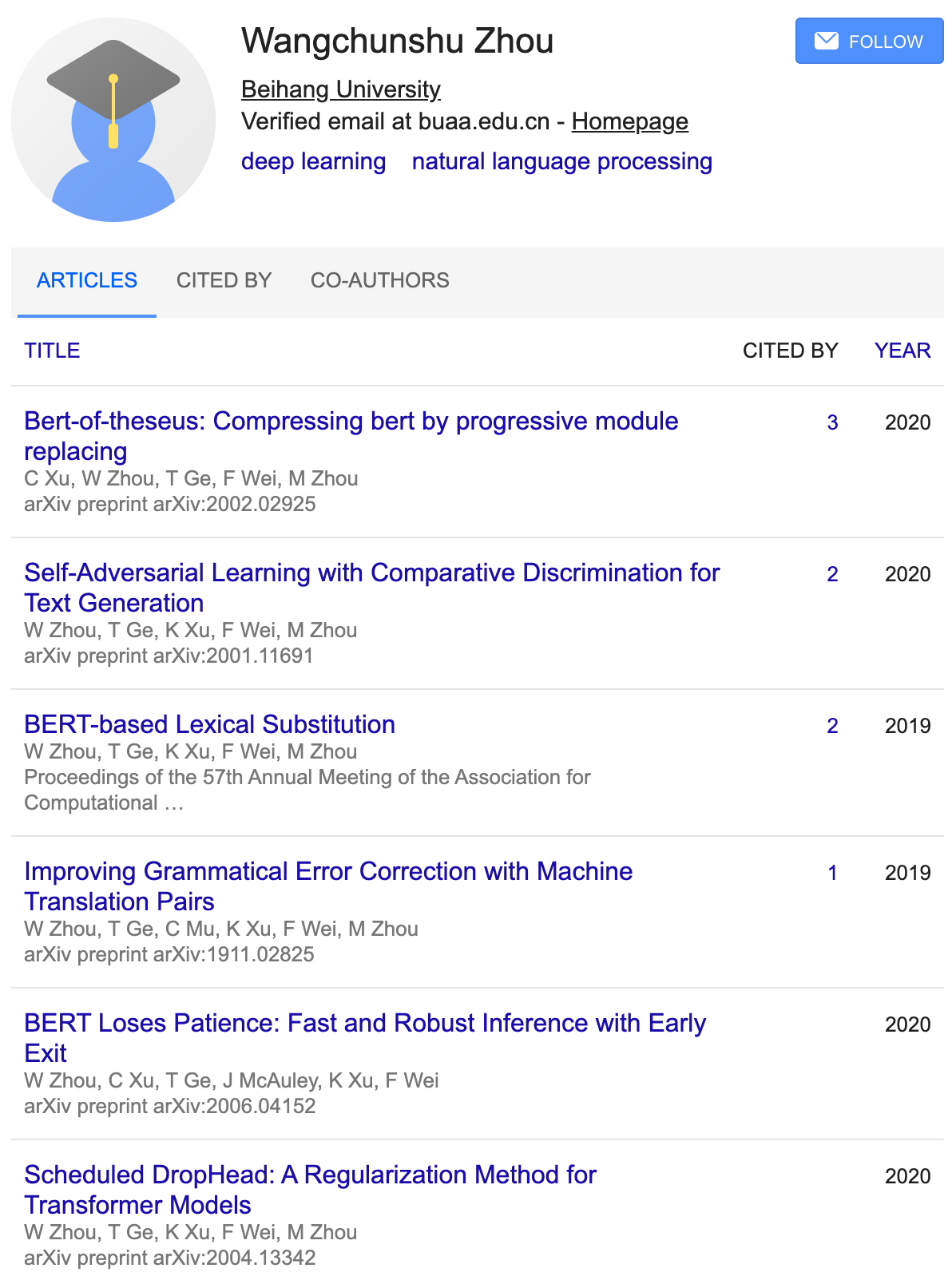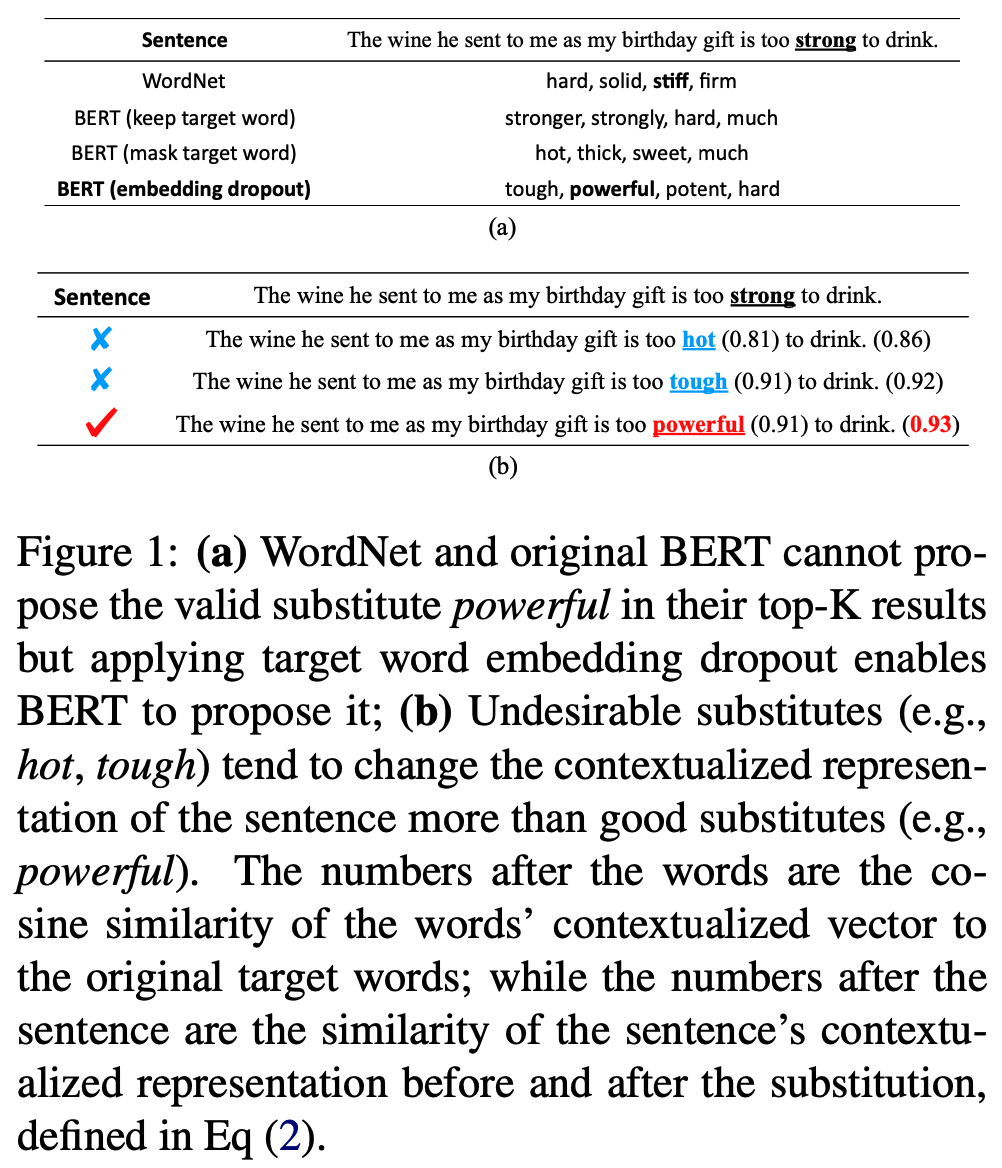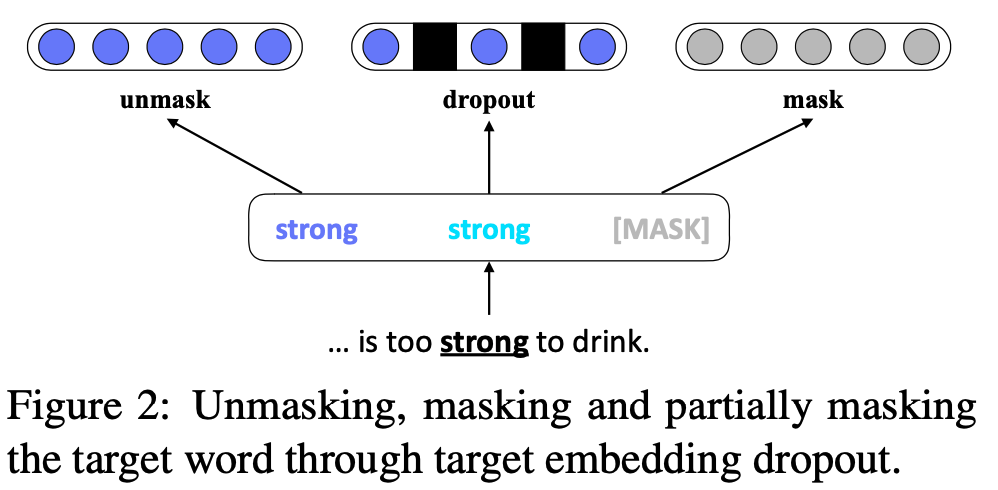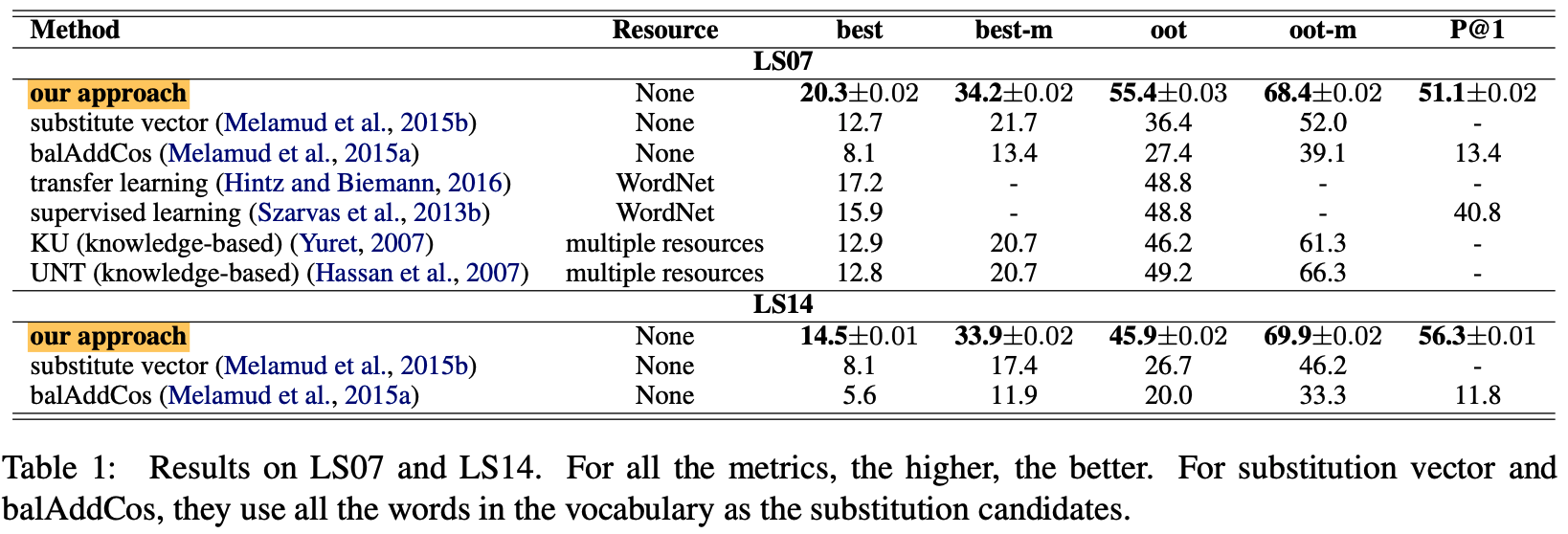BERT-based Lexical Substitution
Author
- 논문 매우 많이 씀
- AAAI, ACL, ICLR 등 탑티어 컨퍼런스 논문냄
- 마소에서 인턴했고 2021 fall 박사과정 자리 구하는중 (아직 석사라는 뜻)
- 개인블로그 운영: https://michaelzhouwang.github.io/
 {: height=”50%” width=”50%”}
{: height=”50%” width=”50%”}  {: height=”30%” width=”30%”}
{: height=”30%” width=”30%”}
- 저자:
- Wangchunshu Zhou, Ke Xu (Beihang University)
- Tao Ge, Furu Wei, Ming Zhou (Microsoft Research Asia)
Abstract
- 이전 연구들은 lexical resources (e.g. WordNet)으로 부터 타겟의 동의어를 찾아서 substitute candidates를 얻어서 context를 보고 랭킹하는 식의 연구였음
- 이런 연구들은 두가지 한계점이 있음
- 타겟 단어의 synonyms 사전에 없는 good substitute candidates를 찾아내지 못함
- substitution이 문장의 global context에 주는 영향을 고려하지 못함
- 이 문제를 해결하기 위해, end-to-end BERT-based lexical substitution approach를 제안함
- annotated data or manually curated resources 없이 만든 substitute candidates 제안하고 검증함
- target word’s embedding 에 dropout 적용해서 target word’s semantics and contexts for proposing substitute candidates를 고려할 수 있게함
- SOTA 찍음 (LS07, LS14 benchmark)
Introduction
- Lexical substitution은 문장의 의미를 바꾸지 않고 단어를 바꿔주는 task를 말함
- text simplication and paraphrase generation task와 비슷함
- 비슷한 단어 찾기와 맥락 의미 유지 두가지가 중요한데 대부분의 선행 연구는 첫번째 (동의어로 교체)에 초점이 맞춰짐
 {: height=”40%” width=”40%”}
{: height=”40%” width=”40%”}
- 하지만 사전같은 리소스는 제한되어 있고, 바꾼 단어가 문장에 어떤 영향 주는지를 고려못함
BERT-based Lexical Substitution
Substitute Candidate Proposal
- 마스킹해버리면, 문장의 맥락상으론 맞지만 단어적으로는 틀린 단어 생성함
- 반대로 마스킹 안하면 거의 99.99% 의 확률로 original target word를 예측함
- 위 두개 방법의 trade-off를 고려해서 embedding dropout 하는걸 선택
- 문장이 있을때 문장에서 k 번째 단어를 나타내는 표현을 아래와 같이 한다고 할 때
$${\boldsymbol{x}=\left(x_{1}, \cdots, \underline{x}{k}, \cdots, x{L}\right)}$$
- proposal score $s_{p}\left(x_{k}^{\prime} | \boldsymbol{x}, k\right)$ 는 $x_{k}$의 대체 단어로 $x_{k}^{\prime}$ 를 선택하는 점수임
$s_{p}\left(x_{k}^{\prime} | \boldsymbol{x}, k\right)=\log \frac{P\left(x_{k}^{\prime} | \widetilde{\boldsymbol{x}}, k\right)}{1-P\left(x_{k} | \widetilde{\boldsymbol{x}}, k\right)}$
- $P\left(x_{k} | \boldsymbol{x}, k\right)$ 는 x라는 주어진 문장이 있을 때 k 번째 단어가 예측될 확률임
- $P\left(x_{k}^{\prime} | \widetilde{\boldsymbol{x}}, k\right)$ 이거는 k 번째 단어가 partially masked with embedding dropout인 경우임
- 분모 나눈건 origin word 의 확률을 빼줘서 normalize 해준 것임
 {: height=”50%” width=”50%”}
{: height=”50%” width=”50%”}
1 | token_prediction_scores = prediction_scores[문장내에서 변경할 토큰 위치, bert_token_index] |
Substitute Candidate Validation
- 단어가 이상하게 선택되면 원래 문장과 의미가 달라지니, before after의 contextual representation을 비교하고자함
- BERT의 top four layer 의 representation을 concat해서 사용하겠음
- 단어가 교체된 문장은 다음과 같이 씀
$$
\boldsymbol{x}^{\prime}=\left(x_{1}, \cdots, x_{k}^{\prime}, \cdots, x_{L}\right)
$$ - 이때 validation score는 다음과 같음
$$
s_{v}\left(x_{k}^{\prime} | \boldsymbol{x}, k\right)=\operatorname{SIM}\left(\boldsymbol{x}, \boldsymbol{x}^{\prime} ; k\right)
$$ - SIM은 두 문장에 대한 BERT’s contextualized representation similarity 임
$$
\operatorname{Sim}\left(\boldsymbol{x}, \boldsymbol{x}^{\prime} ; k\right)=\sum_{i}^{L} w_{i, k} \times \Lambda\left(\boldsymbol{h}\left(x_{i} | \boldsymbol{x}\right), \boldsymbol{h}\left(x_{i}^{\prime} | \boldsymbol{x}^{\prime}\right)\right)
$$ - $\boldsymbol{h}\left(x_{i} | \boldsymbol{x}\right)$ 는 BERT의 i 번째 토큰에 대한 contextualized representation임
- $\Lambda(\boldsymbol{a}, \boldsymbol{b})$ 은 a, b 벡터의 cosine similarity임
- $w_{i, k}$ 은 i->k 방향의 모든 head에 대한 self-attention score의 평균임
Substitute Candidate Validation
음..오른쪽은 cosine으로 벡터간 유사도 보겠다는 거고 왼쪽은 attention으로 그것의 중요도를 대략 계산해보겠다는 거 같군- 이렇게하면 예제에 나왔던 hot and touch 등의 단어는 validation (s_v) 점수가 낮게 나와서 랭킹에서 떨어지고 반면에 powerful 같은 단어는 높게 나와서 랭킹에서 올라감
- 최종적으로 다음과 같이 점수를 linear combination 해서 단어를 선택할 수 있음
$$
s\left(x_{k}^{\prime} | \boldsymbol{x}, k\right)=s_{v}\left(x_{k}^{\prime} | \boldsymbol{x}, k\right)+\alpha \times s_{p}\left(x_{k}^{\prime} | \boldsymbol{x}, k\right)
$$
1 | input_ids = torch.tensor(token_ids_list, device=device) |
Experiments
Experimental Setting
- target word’s embedding dropout ratio: 0.3
- weight alpha: 0.01
- num candidates: 50
Experimental Results
- original BERT는 기존 sota를 이길 수 없음 (Table 2 참고)
- embedding dropout 후 SOTA 먹음
- GAP score 라는 걸로 평가함 (MAP의 변형임)
 {: height=”50%” width=”50%”}
{: height=”50%” width=”50%”} {: height=”50%” width=”50%”}
{: height=”50%” width=”50%”} {: height=”50%” width=”50%”}
{: height=”50%” width=”50%”}
Conclusion
- annotated data and manually curated resources 없이도 결과 잘 나옴
- end-to-end 모델이고 sota임
BERT-based Lexical Substitution
https://eagle705.github.io/2020-06-18-bert_based_lexical_substitution/